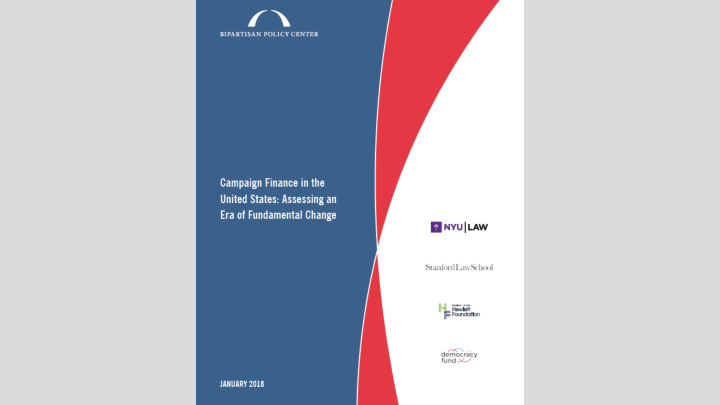



Goal of the Research Effort ■ To reach consensus among a bipartisan group of political scientists as to the fundamental changes occurring in the U.S. campaign finance system in the previous fifteen years. ■ Not Not to propose pose ref efor orms ms, but to establish the factual predicate for a discussion of the changing dynamics of the system.
Key Findings 1. 1. Sup uper r PACs – Most significant change in the system. – Key to understanding the fragmentation of the system and the preferred financing vehicle of a small group of individuals to participate in campaigns. 2. Par Parties ies – The formal party organizations have receded in importance to outside groups/informal party. 3. . Corporation rporations – Citizens United v. FEC, has not led to an explosion in corporate spending. – Unions have taken greater advantage of that decision. 4. . Disclos losure ure – 501(c)(4) groups have become critically important vehicles for donors wishing to give anonymously. – The 2016 election did not see the same level of undisclosed spending as 2012. 5. New w Media ia – Spending on digital campaign communication is rapidly accelerating. – Campaign finance law’s preoccupation with television is becoming increasingly anachronistic with each election. – The major internet platforms are now in a unique position to establish the future rules of campaign financing and political communication.
**Total amount spent on advertising in 2016 on all elections combined: roughly $9.8 billion ($400 million increase over 2012)
More Donors, But Highly Concentrated Donations Number of people giving to candidate campaigns 1982: 65,970 2016: More than 3.2 million Number of people accounting for half of total contributions 2000 – 73,926 2016 – 15,810
Super PACs
Party Receipts
Facts acts Abou bout t Corporat porations ions an and Uni nions ons Corpor rporat ate e Spending ending 2012: $75 million (of which $20 million came from shell corporations for individuals). 2014: 5 percent ($25 million) of Super PAC receipts in 2014 and 2016: 6 percent ($95 million) of Super PAC receipts – “Publicly held companies were the source of less than 1 percent of total Super PAC funding and most of this money came from only a few companies.” (Anthony Corrado) Trade de associa ociati tion ons, s, like e the e U.S. S. Chambe amber of Comm mmer erce ce – 2014: $35 million – 2016: $29 million Unions Un ons – 2012: $105 million on independent expenditures – more than the $60 million labor PACs spent on federal elections or the $96 million spent on federal lobbying efforts) – 2014: $81.6 million on Super PACs – 2016: $93 million on Super PACs – Corrado: In the 2014 and 2016 elections combined, “labor union donations [to Super PACs] exceeded the total amount given by business corporations and trade groups by $32 million.”
Disclosure and 501(c) Spending Spending by 501(c)(4) organizations 2006: $5 million 2008: $69 million 2010: $136 million 2012: $309 million 2016: $147 million
Di Disclosure sclosure
The Shift to Digital Source: Borrell Associates
Th The e Implications plications of the f the Shi hift t to Di Digi gital tal for or Cam ampaign paign Fi Finance nance Regulation egulation ■ Hard to track on line spending – could occur anonymously; anywhere in the world. ■ Disclosure regime ill-fitted for on line spending. ■ Great power now exercised by internet platforms to regulate campaign finance and political communication.
Conclusion nclusion ■ Awash in data, but need more! ■ Fundamental shift to individual donors financing of elections, especially through Super PACs. ■ New vehicles for campaign financing extending along two dimensions: – Extent of Disclosure – Proximity to candidates/parties ■ Money becoming increasingly difficult to track – online, 501(c) organizations ■ The preoccupation of the campaign finance regime with television will become increasingly anachronistic….
Recommend
More recommend